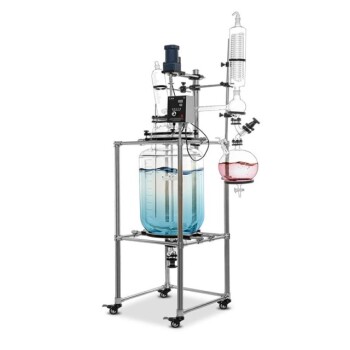The jacket in a reactor is a critical component designed to control the temperature of the reaction mixture by circulating a heating or cooling fluid around the vessel. This ensures uniform heat exchange, enabling precise temperature regulation, which is essential for achieving consistent and reliable results in chemical reactions. Jackets come in various types, such as dimple jackets, plate coils, half-pipe coil jackets, and conventional jackets, each suited for specific applications. They are particularly useful in processes like cannabinoid processing, where single or dual jacket systems are employed to maintain optimal temperatures. Overall, reactor jackets enhance temperature control, improve product quality, and facilitate scalable reactions.
Key Points Explained:

-
Purpose of a Reactor Jacket:
- The primary function of a reactor jacket is to regulate the temperature of the reaction mixture inside the vessel. This is achieved by circulating a heating or cooling fluid (such as water, oil, or glycol) around the jacket, ensuring efficient heat transfer between the fluid and the vessel walls.
- Temperature control is crucial in chemical processes, as it directly impacts reaction rates, product quality, and yield.
-
Types of Jackets:
- Dimple Jackets: These feature small indentations (dimples) on the jacket surface, which increase the surface area for heat transfer. They are ideal for applications requiring high heat transfer efficiency.
- Plate Coils: These consist of plates welded to the vessel, providing a large heat transfer area. They are suitable for processes requiring rapid heating or cooling.
- Half-Pipe Coil Jackets: These are semi-circular pipes welded around the vessel, offering robust construction and high-pressure resistance. They are commonly used in high-temperature or high-pressure applications.
- Conventional Jackets: These are simple, hollow jackets that surround the vessel. They are versatile and widely used in general-purpose reactors.
-
Single vs. Dual Jacket Systems:
- Single Jacket System: In this setup, a chiller circulates a cooling or heating fluid through the jacket. It is commonly used in processes where moderate temperature control is sufficient.
- Dual Jacket System: This system includes an inner jacket for fluid circulation and an outer jacket for vacuum insulation. It is particularly useful in processes requiring precise temperature maintenance, such as cannabinoid processing.
-
Importance of Temperature Control:
- Jacketed reactors provide uniform heat exchange, ensuring consistent reaction conditions. This is vital for scaling up reactions and improving yield.
- Enhanced temperature control leads to better product quality, as it minimizes side reactions and ensures the desired reaction pathway is followed.
-
Applications of Jacketed Reactors:
- Jacketed reactors are widely used in industries such as pharmaceuticals, chemicals, and food processing. For example, in cannabinoid processing, jacketed reactors maintain the required temperatures for extraction and purification.
- They are also essential in processes like polymerization, crystallization, and distillation, where precise temperature control is critical.
-
Components of a Jacketed Reactor:
- A jacketed reactor typically consists of:
- Kettle Body: The main vessel where the reaction occurs.
- Jacket: Surrounds the kettle body and circulates the heat transfer fluid.
- Stirrer: Ensures uniform mixing of the reaction mixture.
- Transmission Device: Powers the stirrer.
- Shaft Sealing Device: Prevents leaks and contamination.
- A jacketed reactor typically consists of:
-
Advantages of Jacketed Reactors:
- They enable precise temperature control, which is essential for optimizing reaction conditions.
- They improve scalability, allowing reactions to be conducted on a larger scale without compromising quality.
- They enhance safety by reducing the risk of overheating or overcooling, which can lead to dangerous reactions.
By understanding the role and types of reactor jackets, as well as their applications and benefits, equipment purchasers can make informed decisions when selecting reactors for specific processes.
Summary Table:
| Aspect | Details |
|---|---|
| Purpose | Regulates temperature by circulating heating/cooling fluid around the vessel. |
| Types of Jackets | Dimple jackets, plate coils, half-pipe coil jackets, conventional jackets. |
| Single vs. Dual Jacket | Single: Moderate control; Dual: Precise control with vacuum insulation. |
| Applications | Pharmaceuticals, chemicals, food processing, cannabinoid processing. |
| Key Components | Kettle body, jacket, stirrer, transmission device, shaft sealing device. |
| Advantages | Precise temperature control, improved scalability, enhanced safety. |
Discover how reactor jackets can optimize your chemical processes—contact us today for expert guidance!










